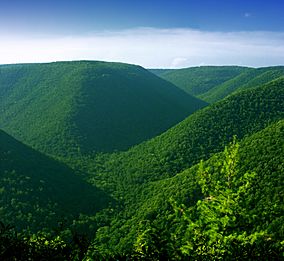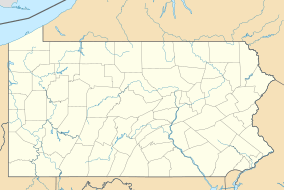Elk State Forest facts for kids
Quick facts for kids Elk State Forest |
|
|---|---|
|
IUCN Category VI (Managed Resource Protected Area)
|
|

Jerry Ridge Vista, Elk State Forest, in Cameron and Clinton Counties
|
|
| Location | Pennsylvania, United States |
| Area | 200,000 acres (810 km2) |
| Elevation | 1,686 ft (514 m) |
| Established | 1900 |
| Governing body | Pennsylvania Department of Conservation and Natural Resources |
| Website | Elk State Forest |
Elk State Forest is a huge natural area in Pennsylvania, managed by the state. It's located mostly in Cameron and Elk counties. You can find its main office in Emporium.
This forest covers about 200,000 acres (which is about 80,937 hectares). That's a lot of land for exploring! Small parts of the forest also reach into Clinton, McKean, and Potter counties.
Contents
History of Elk State Forest
From Lumber to Wildland
The story of Elk State Forest is a lot like other state forests in Pennsylvania. In the early 1900s, the state bought much of this land from big lumber companies. Before that, in the mid-to-late 1800s, these companies had cut down almost all the very old, tall trees.
First, they harvested huge white pines. These trees were perfect for making masts and spars for ships. Workers would tie the logs together and float them down rivers like the West Branch Susquehanna River all the way to shipyards in Baltimore.
After the white pines were gone, lumberjacks started cutting down hemlock trees. Many sawmills and lumber camps popped up in the area. Timber was floated down smaller rivers like Driftwood Branch and Bennett's Branch to the West Branch Susquehanna River. The lumber era in this area ended around 1915.
Rebuilding the Forest
After the lumber companies left, the forest looked very different. It was mostly tree stumps and dry treetops. Sparks from passing steam trains often caused huge wildfires. These fires made it hard for new trees to grow.
During the Great Depression, President Franklin D. Roosevelt started the Civilian Conservation Corps (CCC). This program helped bring the forests back to life. Young men from the CCC worked hard to clear away dry brush that fueled wildfires. They also built roads, trails, and bridges throughout Elk State Forest.
Sadly, on October 19, 1938, eight young CCC members died while fighting a wildfire near Pepperhill. They were trapped on a steep hillside. Today, the Wayside Memorial Spring near Emporium honors these brave men.
Pennsylvania's Elk Herd
Return of the Elk
Elk State Forest is named after the amazing animal, the elk (also called wapiti). Elk used to live all over Pennsylvania. But by 1867, the last wild elk in Pennsylvania was gone.
However, between 1913 and 1926, elk from the Rocky Mountains were brought back to this area. Today, the herd has grown to over 600 animals! This is a big increase from only 35 elk counted in the 1970s. Most of these elk live in southeastern Elk and southwestern Cameron counties.
Managing the Herd
The Pennsylvania Game Commission helps take care of the elk herd. They manage the forest to make sure the elk have enough food. Sometimes, they sell groups of trees to lumber companies. When new trees grow in their place, they provide different kinds of food that elk like to eat. The Game Commission also keeps grassy areas open for the elk to graze.
Seeing Elk Safely
If you visit Elk State Forest, you might be lucky enough to see an elk! The best time to spot them is often during their mating season, which happens in September and October.
It's very important to always keep a safe distance from any elk you see. This is especially true for male elk (called bull elk) during mating season. They can be very protective and dangerous.
Neighboring State Forests
- Susquehannock State Forest (north)
- Sproul State Forest (east)
- Moshannon State Forest (south)
- Clear Creek State Forest (southwest)
- Cornplanter State Forest (west)
Nearby State Parks
Natural Areas and Trails to Explore
Elk State Forest has several special natural areas and many trails for hiking:
- Quehanna Wild Area (48,186 acres)
- Johnson Run Natural Area (216 acres)
- Lower Jerry Run Natural Area (892 acres)
- Pine Tree Trail Natural Area (276 acres)
- Bucktail State Park Natural Area (16,433 acres)
- M.K. Goddard/Wykoff Run Natural Area (1,215 acres)
Some of the main hiking trails include:
- Bucktail Path
- Quehanna Trail
- Fred Woods Trail
- Elk Trail


